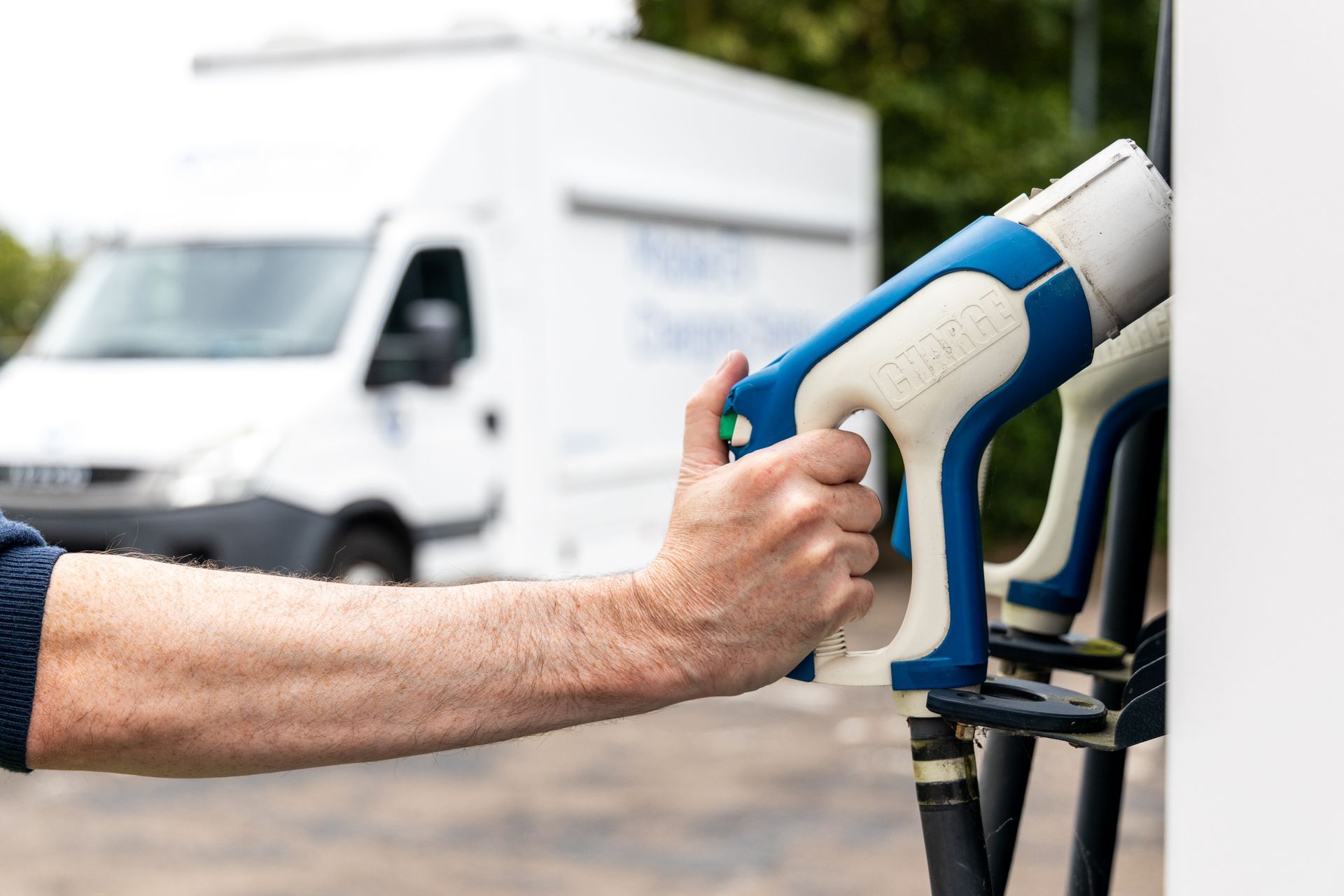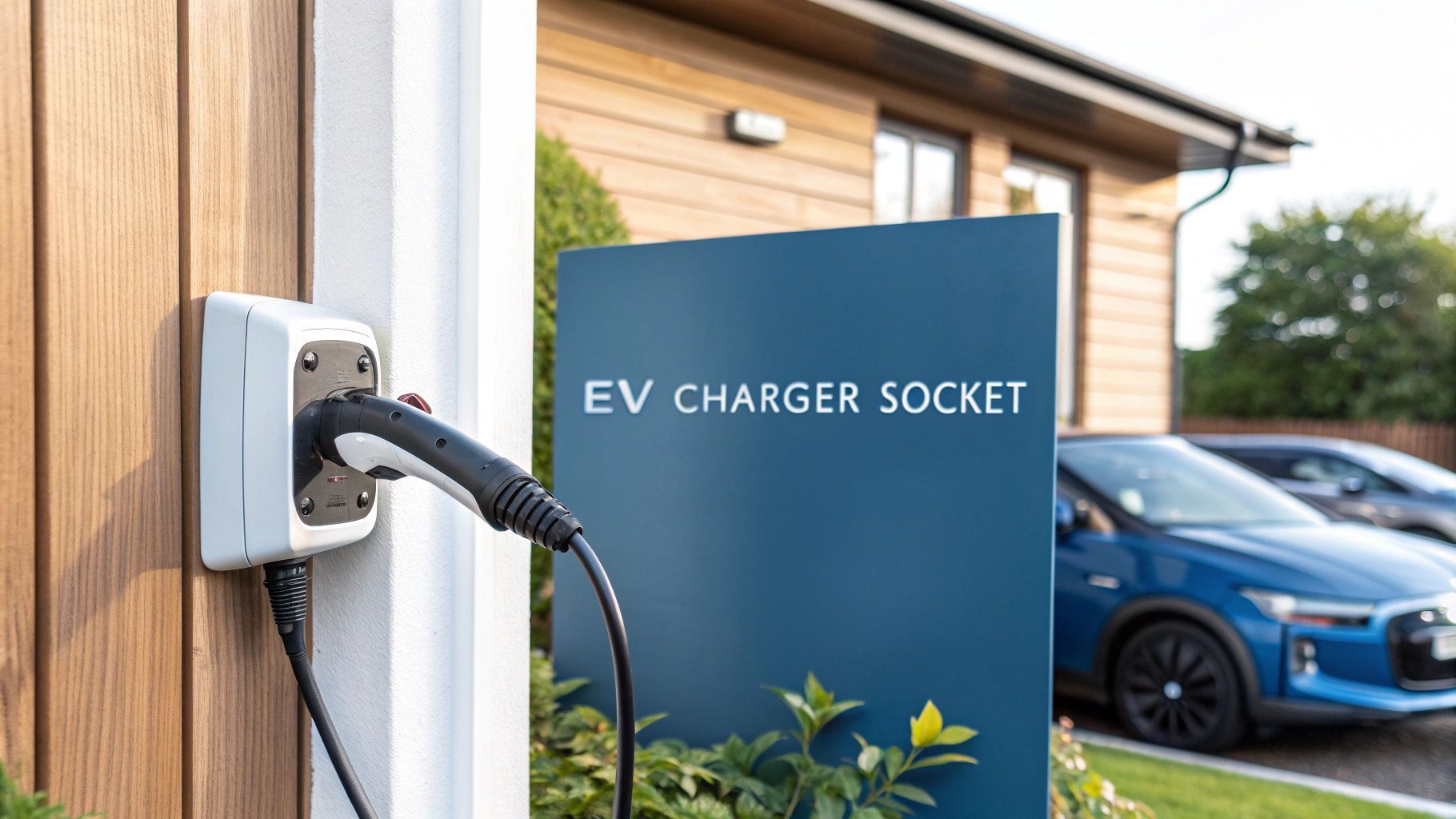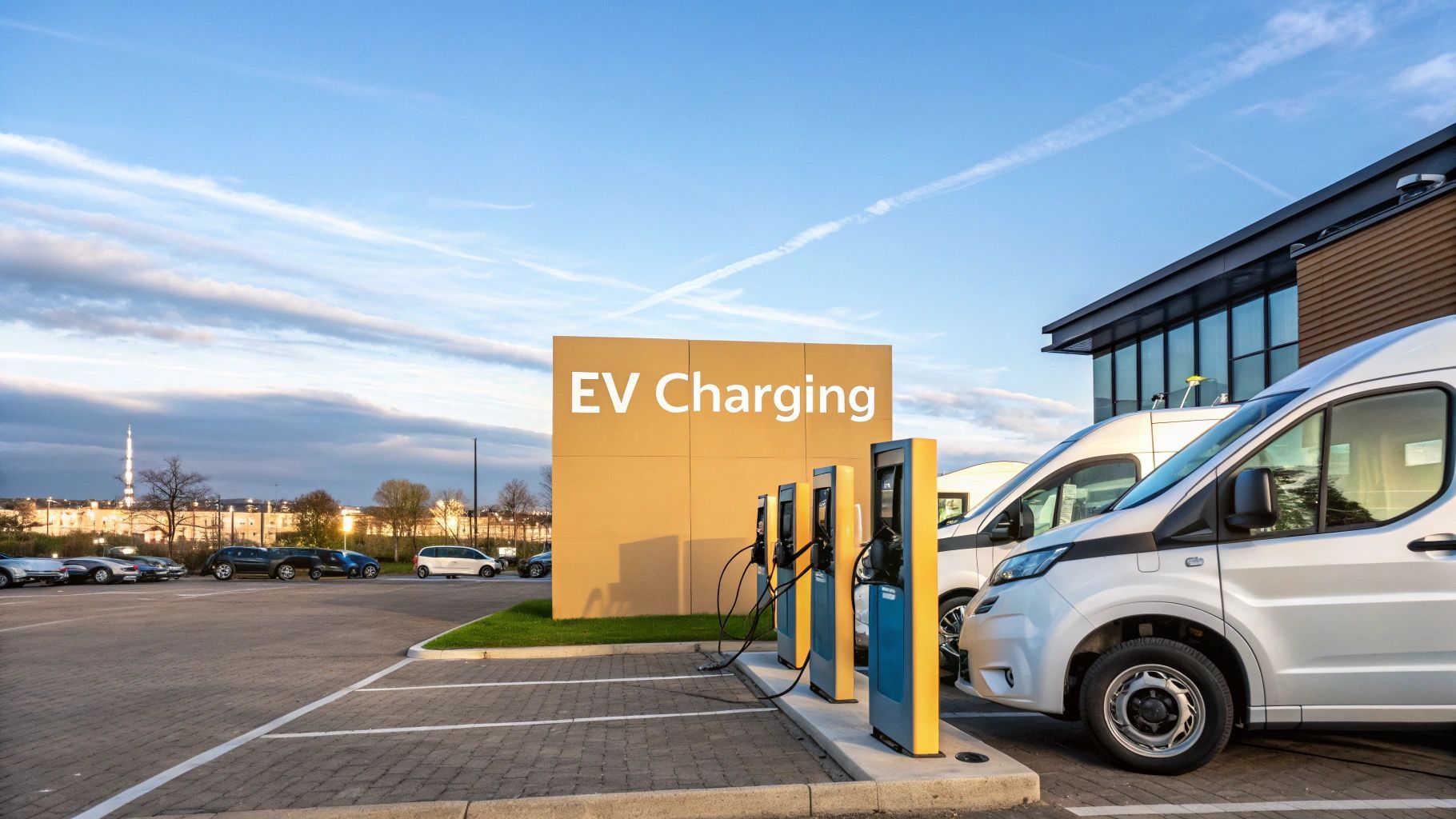UK Commercial EV Charging Installation Guide
Installing a commercial EV charging setup is about more than just plugging in a box. It's a strategic move that involves careful planning, picking the right gear and managing the whole process to turn your car park into a real asset. For UK businesses, it’s quickly becoming a way to generate new revenue while showing a serious commitment to sustainability.
Your Commercial EV Charging Installation Journey
Welcome to your no-nonsense guide for installing commercial EV chargers in the UK. As electric vehicles become a common sight on our roads, setting up charging points has gone from a nice-to-have to a smart business decision. This guide will walk you through everything, from that first spark of an idea to running a profitable charging hub.
There's never been a better time for UK businesses to jump in. The sheer number of new EV drivers means there's a ready-made market and government incentives are still available to help soften the initial investment. Think of it this way: these chargers aren't just another amenity for customers; they're a brand-new, exciting revenue stream waiting to be tapped.
We'll cover the core phases you need to get right:
- Assessing Your Site: Really understanding your property’s electrical capacity and how people move around it.
- Choosing the Right Hardware: Getting to grips with the difference between AC destination chargers and DC rapid chargers and which makes sense for you.
- Navigating Funding and Permissions: How to secure grants and deal with the paperwork from local authorities.
- The Installation Process: From the moment the ground is broken to the day you go live.
The UK's Rapidly Growing Charging Network
The UK’s charging network is expanding at an incredible pace, thanks to a mix of government policy and private investment. Since 2015, the focus has been on growing the public network, improving both the number and quality of chargers out there. Projections show the UK is on track to have around 18,000 public rapid chargers by 2025, plus thousands of slower units dotted across towns and rural spots. This push is building a solid backbone for the UK's shift to electric transport, supporting everyone from commercial fleets to shoppers at retail parks. You can get a deeper dive into the UK's evolving EV landscape at evchargerpost.com.
Mobile Charging: A Lucrative Alternative
While fixed chargers are the standard, mobile EV charging is emerging as a uniquely flexible and profitable option. Imagine running a mobile charger as a service—you could bring in serious income by providing power exactly where it's needed most. An operator could deploy a mobile unit at a big festival, a business park with poor infrastructure, or even offer a premium roadside rescue service for stranded EV drivers.
The real beauty of mobile charging is its ability to follow the demand. You're not tied to one spot, which lets you tap into different markets and high-traffic events that fixed chargers simply can't reach.
This model neatly sidesteps the high costs and long waits that come with grid connections and planning permission. You can start earning almost straight away. A single mobile charging unit, serving several clients a day, can quickly become a very profitable asset, turning an EV driver's downtime into your direct income. An operator could easily see returns of hundreds of pounds per day from a single unit by offering a premium, on-demand service.
Mastering Your Site Assessment and Plan

Before a single cable is laid or a charger is mounted, a successful commercial EV charging installation begins with a thorough site assessment. This is the bedrock of your entire project. It determines not just the cost and timeline but the long-term profitability of your investment. It’s all about looking at your property with a fresh pair of eyes to understand its unique potential.
The first port of call is always your electrical infrastructure. Your property’s current electrical capacity will dictate the type and number of chargers you can realistically install without major, costly upgrades. A grid connection survey is a non-negotiable step, usually handled by your Distribution Network Operator (DNO).
This survey reveals exactly how much power is available and what it might cost to get more if needed. Trust me, ignoring this can lead to some eye-watering unexpected expenses and delays down the line.
Pinpointing the Perfect Charger Locations
Once you have a clear picture of your power supply, the next job is to identify the best physical locations for your chargers. Visibility and accessibility are paramount. You want drivers to see your chargers easily from the main entrance, as this acts as a powerful advertisement for your forward-thinking facilities.
When choosing your spots, think about these key factors:
- Proximity to Power: The closer the chargers are to your main electrical room, the lower your trenching and cabling costs will be. It's a simple equation that can save you a small fortune.
- Safety and Lighting: Make sure the charging bays are well-lit and in a safe, monitored area of your car park. This gives drivers peace of mind, especially after dark.
- Driver Convenience: Place chargers in locations that are easy to drive into and out of. Avoid tight corners or spots that could cause obstructions for other vehicles.
Analysing your traffic flow is just as critical. Watch how vehicles currently move through your car park during peak and off-peak times. The goal is to integrate the charging bays seamlessly, ensuring they don’t create bottlenecks or disrupt the natural flow. A poorly placed charger can cause more frustration than it solves.
To learn more about getting the most out of your space, check out our guide on how to enhance your car park business with secondary services .
Understanding Your Audience and the Market
A key part of your plan is defining who you are serving. Are these chargers primarily for your staff who park all day, for customers making a quick visit, or for the general public? The answer will directly influence your hardware choice.
Staff might only need slower AC chargers, whereas a retail park will benefit hugely from rapid DC units that can provide a significant charge in under an hour.
It's also incredibly wise to analyse the local market. Regional disparities in charger availability across the UK are stark and this presents a strategic opportunity. By July 2025, Greater London had over 25,502 public chargers, making up about 30% of the UK's total. In contrast, Northern Ireland had just 707 .
This data highlights significant gaps in the market. If your business is in an underserved area, installing chargers could make you the key destination for local EV drivers.
A detailed site assessment doesn’t just prevent problems; it reveals opportunities. By understanding your electrical limits, traffic flow and local market gaps, you can transform a standard installation into a highly strategic and profitable asset for your business.
Ultimately, a well-executed site assessment and plan is your roadmap to success. It ensures your installation is not only feasible and compliant but also perfectly tailored to meet the needs of your users, maximising both its utility and your return on investment.
Choosing the Right Charging Hardware and Software
Picking the right equipment is one of the most important decisions you'll make when setting up a commercial EV charging station. This choice directly impacts your service's performance, how happy your users are and, ultimately, your bottom line. It's not just about buying a charger; it's about building a complete system that fits your business goals.
Matching Charger Speed to Your Business Needs
The first big choice is between AC (Alternating Current) and DC (Direct Current) fast chargers. Think of AC chargers as the marathon runners of the EV world. They deliver power more slowly, usually between 7kW and 22kW , which makes them perfect for 'destination' charging where vehicles will be parked for a few hours.
This makes them a great, cost-effective option for workplaces, hotels and residential car parks. Employees or guests can simply plug in and top up their batteries over a full day or overnight without any rush.
DC fast chargers, on the other hand, are the sprinters. These units can deliver anywhere from 50kW to over 350kW of power, adding significant range in as little as 20-30 minutes . This speed is essential for locations where drivers need a quick turnaround.
Let's look at a few real-world examples:
- Retail Parks and Supermarkets: DC rapid chargers are a must-have here. They let shoppers gain a substantial amount of range while they're in the store for an hour or so, adding real value to their visit.
- Motorway Service Stations: For drivers on long journeys, rapid and ultra-rapid DC chargers are the only practical choice to keep travel times down.
- Business Fleets: A mix often works best. Slower AC chargers are ideal for overnight depot charging, while a rapid DC unit can provide quick top-ups during the day to keep the fleet moving.
The UK’s public charging network reflects this blend. As of early 2024, the nation had 76,507 public charging devices. While the majority ( 56% ) are slower AC chargers for destination use, a significant 20% are rapid DC chargers rated at 50kW or higher, showing the growing need for fast turnarounds. You can dig into the full government data on the UK's charging infrastructure to see how the network is developing.
The Power of Smart Charging and Management
Modern commercial charging is about much more than just electricity. Smart features are vital for running an efficient and profitable operation. Load management , for instance, is a key function that intelligently balances the available power across multiple chargers. This stops you from overloading your site’s electrical capacity during peak times and can save you from needing expensive grid upgrades.
Payment systems also need careful thought. While traditional RFID cards still have their place, most drivers now expect simple contactless payment via debit/credit card or a mobile app. The easier it is for someone to pay, the more likely they are to use your service.
The image below shows some of the compelling financial and environmental benefits that a well-planned commercial charging setup can deliver.

This data clearly shows that investing in EV charging can lead to a very reasonable payback period while offering significant yearly savings and a positive environmental impact.
To help you decide, this table breaks down the key differences between the two main types of chargers.
Comparison of Commercial EV Charger Types
| Feature | AC Charger (Destination) | DC Fast Charger (Rapid) |
|---|---|---|
| Charging Speed | Slow (7-22kW) | Very Fast (50-350kW+) |
| Typical Charge Time | 2-8+ hours | 20-60 minutes |
| Best Use Case | Long-stay parking (workplaces, hotels) | Quick turnaround (retail, motorways) |
| Installation Cost | Lower | Higher |
| Grid Impact | Minimal | Significant, may need upgrades |
| Hardware Footprint | Smaller | Larger |
Ultimately, your choice depends entirely on how your customers will use the chargers. AC is perfect for dwell time, while DC is all about speed and convenience.
Choosing Your Charge Point Management System
Behind every successful network of chargers is a reliable Charge Point Management System (CPMS) . This software is the central brain of your operation, allowing you to monitor the status of your chargers in real-time, set custom pricing, analyse usage data and even perform remote diagnostics.
A robust CPMS is non-negotiable. It transforms your hardware from simple power outlets into intelligent, revenue-generating assets that you can control from anywhere.
A good CPMS gives you the flexibility to adapt your business model on the fly. You could offer free charging for staff during the day but charge the public in the evenings, or even set up loyalty discounts to keep customers coming back.
Exploring the Advantages of Mobile Charging
While fixed installations are the traditional route, mobile charging offers a powerful and flexible alternative for many businesses. This approach avoids the lengthy delays and high costs often associated with grid connections and planning permission, letting you generate revenue almost immediately.
Imagine the potential earnings from providing on-demand charging at a music festival, a corporate event, or a busy construction site. An operator with a single mobile unit could make hundreds of pounds in profit a day by serving high-demand, temporary locations. For businesses looking to enter the market quickly or serve diverse locations, exploring options like ZAPME mobile chargers can unlock new revenue streams that fixed hardware simply can't match. This agility is a massive advantage in the fast-moving EV market.
Securing Funding and Navigating UK Regulations

Embarking on a commercial EV charging project is about more than just hardware and digging trenches. The financial and regulatory hurdles can feel like a maze but getting them right from the start is absolutely essential for a smooth rollout.
Successfully navigating UK grants and planning laws will not only keep your project on schedule but will also shield your budget from any nasty surprises. The good news is, the UK government wants to help businesses invest in this infrastructure and there are schemes designed to soften the initial financial blow.
Unlocking Government Grants and Schemes
For most businesses, the first port of call for funding is the Workplace Charging Scheme (WCS) . Run by the Office for Zero Emission Vehicles (OZEV), this is a voucher-based scheme that helps cover the upfront costs of buying and installing EV charge points.
The WCS is open to any registered business, charity, or public sector organisation in the UK. It offers up to £350 per charging socket , with a cap of 40 sockets across all your sites. Do the maths, and that’s a potential £14,000 in funding – a significant dent in your initial outlay.
So, how do you qualify? Your business must:
- Be a registered business, charity, or public sector organisation.
- Have dedicated off-street parking for your staff or fleet.
- Own the property or have the landlord's permission to install the chargers.
- Crucially, use an OZEV-approved installer for the job.
It’s also worth looking beyond the WCS. Some local authorities have their own localised grants and infrastructure funds available. It never hurts to check if any regional schemes can be stacked on top of national funding to maximise your savings. Properly exploring the various finance options for EV chargers is a vital step in building a solid business case for your project.
Demystifying Planning Permission
One of the biggest worries for businesses is getting tangled up in planning permission. The regulations might seem complex but the reality is that many commercial EV charging installations fall under permitted development rights . This is great news, as it means you may not need to submit a full planning application at all, saving a huge amount of time and money.
Permitted development rights usually cover wall-mounted chargers or charging posts in off-street car parks, provided they meet certain conditions. For instance, the charging post and its equipment can't be taller than 2.3 metres and the installation must be at least two metres away from a public highway.
Be warned, though: if your property is a listed building or sits within a conservation area, a World Heritage Site, or an Area of Outstanding Natural Beauty, permitted development rights almost certainly won't apply. You must always check with your local planning authority before starting any work.
Getting this wrong can lead to enforcement action from the council, which could mean ripping out the chargers and starting the whole process again. A quick, informal chat with a planning officer beforehand can clear up any confusion and prevent a very costly mistake.
Adhering to Electrical and Safety Standards
Compliance with UK electrical regulations is completely non-negotiable. This isn’t an area for cutting corners. All installation work has to be done by a qualified electrician and must conform to the latest edition of the BS 7671 IET Wiring Regulations . These standards are there to ensure the installation is safe for everyone who uses it and plays nicely with the national grid.
On top of that, all new charge points must comply with the Electric Vehicles (Smart Charge Points) Regulations 2021 . This law requires chargers to have smart functionality, meaning they can schedule charging for off-peak hours to ease grid strain and provide useful data on energy consumption.
This is another reason why choosing an OZEV-approved installer is so important. It’s not just a box-ticking exercise for the grant; it’s your assurance that the work will meet every technical and safety standard. These installers have the specialist knowledge needed for a fully compliant commercial EV charging installation .
Monetising Your Chargers for Maximum ROI

A commercial EV charging installation is far more than just another facility expense; it’s a powerful revenue-generating asset waiting to be unlocked. Once you move past the initial setup costs, the real opportunity lies in turning your charging stations into a profitable and sustainable business line. This requires a smart approach to pricing, a genuine understanding of your users and a laser focus on delivering a service that keeps drivers coming back.
The first step is nailing down a pricing model that works for your location and your customers. Getting this right is the absolute cornerstone of achieving a healthy return on your investment. The most common models each have their own advantages and are suited to different types of businesses.
Selecting Your Pricing Strategy
There are three primary ways to charge for EV charging and the best choice often comes down to how long your customers typically stay.
- Per-Kilowatt-Hour (kWh) Pricing: This is easily the fairest and most transparent method. Drivers pay only for the energy they actually use, much like filling a car with petrol. This model is perfect for rapid charging hubs where the main goal is a quick energy top-up.
- Per-Session Fee: This is a simple, flat fee for plugging in, no matter how much energy is consumed. It works well in places like hotels or workplaces where a driver might be connected for hours but only needs a small top-up.
- Time-Based Fees: Charging by the minute or hour is a great way to encourage driver turnover, which is vital at busy sites with high demand. This model can also include idle fees , which penalise drivers for leaving their fully charged car in a bay, freeing up the space for the next person.
Many businesses I've seen find success with a hybrid approach. For instance, you might combine a per-kWh rate with a time-based fee that kicks in after a certain period to ensure chargers stay available. Whatever you choose, transparency is key—drivers really appreciate clear pricing without any hidden costs.
The Lucrative World of Mobile Charging
While fixed chargers are excellent for established locations, the real game-changer for many operators is mobile charging. This business model offers flexibility you just can't get with static hardware and opens up significant revenue streams. For businesses with service vehicles or fleets, offering on-demand charging can become a highly profitable venture.
Just think about the earning potential. A mobile charging operator can generate substantial income by providing a premium, convenient service precisely where it's needed most. You could deploy a mobile unit at a weekend music festival, a corporate event, or a large construction site where fixed infrastructure is non-existent.
A single mobile charging unit can become a serious money-maker. By charging a premium for on-demand service at a business park or rescuing a stranded driver, an operator can generate significant revenue from one vehicle, turning a driver's problem into your profitable solution.
The financial advantages are compelling. With mobile charging, you bypass the often lengthy and expensive processes of securing grid connections and planning permission. An operator can start generating revenue almost immediately, serving multiple clients across different locations in a single day. This agility allows you to follow the demand and tap into high-value opportunities as they pop up. A single van equipped with a mobile charger, for example, could service an entire industrial estate, earning revenue from multiple businesses without the massive capital outlay of a fixed installation for each one.
Building a Loyal Customer Base
Ultimately, your long-term profitability hinges on creating a loyal user base that chooses your site over the competition. Excellent reliability is the bedrock of this loyalty. A charger that's frequently out of order will quickly tarnish your reputation.
To make your site a go-to destination, focus on these areas:
- Transparent and Fair Pricing: Make sure your pricing is clearly displayed and easy to understand. Nobody likes surprises when it comes to the bill.
- Exceptional Reliability: Invest in high-quality hardware and a robust management system to maintain high uptime. A reliable network is a trusted network.
- Loyalty Schemes: Offer discounts or rewards for repeat customers. A simple points system or a membership model can encourage drivers to make your location their preferred charging stop.
By combining a smart pricing strategy with a focus on reliability and customer incentives, you can transform your commercial EV charging installation from a simple amenity into a thriving and profitable part of your business.
Your Commercial EV Charging Questions Answered
Even with a solid plan, it’s completely normal to have a few questions rattling around before you commit to a commercial EV charging installation . Let’s tackle some of the most common queries we hear from businesses, giving you clear, straightforward answers to help you move forward with confidence.
How Much Can a Commercial EV Charger Realistically Make in the UK?
This is the big one, isn’t it? The honest answer is: it depends. Your revenue hinges on your location, the speed of your chargers, what you pay for electricity and of course, your pricing model.
A well-placed 50kW rapid charger at a busy retail park or service station could certainly generate several thousand pounds in profit each year. To put it into perspective, a single rapid charger used for just four hours a day with a modest 20p per kWh profit margin could earn over £1,400 annually. The absolute key is high utilisation.
Mobile charging operators often see even better returns. By offering a premium on-demand service at events, business parks, or for roadside assistance, a single mobile unit can generate significant income, often far exceeding that of a fixed charger with similar usage. An operator targeting high-value clients could realistically see profits of several hundred pounds per day from a single vehicle.
What Is the Biggest Hidden Cost in a Commercial Installation?
Hands down, the most common and expensive surprise is the grid connection upgrade. It’s incredibly easy to underestimate the sheer power draw of multiple rapid chargers. Your site's existing electrical infrastructure might simply not be up to the task.
The Distribution Network Operator (DNO) may determine that you need a new substation or major upgrades to local cabling. This is a process that can easily add tens of thousands of pounds to your budget and push your project timeline back by several months.
An early and thorough site survey isn't just a recommendation; it's essential financial protection. Getting a clear quote from your DNO before you commit to hardware will save you from extremely costly surprises down the road.
Do I Need Special Software to Manage My Chargers?
Yes, for any serious commercial operation, a Charge Point Management System (CPMS) is non-negotiable. Think of this software as the central brain of your charging network. It's just as critical to your success as the physical hardware itself.
A good CPMS is what allows you to:
- Set and adjust pricing remotely: Respond to demand or changing energy costs in real-time.
- Process payments securely: Offer users a range of payment options, from contactless to app-based systems.
- Monitor charger status: Get live updates on which chargers are in use, available, or require maintenance.
- Gather crucial usage data: Analyse trends to understand peak times and user behaviour, helping you optimise your strategy.
It also unlocks vital functions like load balancing to manage your site's energy use efficiently and provides the tools for remote troubleshooting, often letting you fix issues without needing an engineer on-site.
How Long Does the Entire Installation Process Take?
The timeline for a commercial EV charging installation can vary enormously, from just a few weeks to well over a year. There’s no single answer but we can look at a couple of typical scenarios.
A straightforward installation of a few AC chargers at a site with plenty of electrical capacity might be wrapped up in 4-8 weeks . This would cover the survey, ordering hardware and the physical installation itself.
However, a large-scale project with multiple DC rapid chargers that needs a grid upgrade and full planning permission is a different beast entirely. This kind of project can easily take 6-12 months or even longer from start to finish. The biggest delays are almost always the lead times from the DNO for the grid connection and the local authority's planning department.
Ready to bypass the complexities of fixed installations and start generating revenue faster? ZAPME offers pioneering mobile EV charging solutions that get your business earning without the long waits and high infrastructure costs. Explore our flexible and powerful mobile chargers at https://www.zapme.biz.











